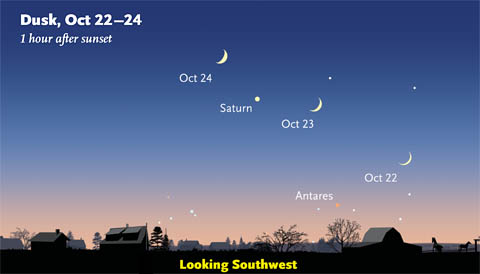October's astronomy podcast helps you track down Saturn after sunset and offers a peek at what's in view before dawn.
This is always an interesting time of year for skwatching. Usually by now the Harvest Moon — the full Moon closest to the date of the September equinox — has come and gone. But this year that honor goes to the full Moon on October 5th, because it falls closer to the equinox than the one back on September 6th.

Sky & Telescope
After the Sun goes down, look well to the left of the sunset point for a glimpse of Saturn. To its immediate left are the stars that form a Teapot-shaped pattern in Sagittarius. To Saturn’s lower right is Antares, which marks the heart of Scorpius. Saturn is fairly low as twilight deepens and sets roughly 3 hours after sunset.
Now make a turn to your right, so that you’re facing north, more or less. Not far above the horizon is our old friend the Big Dipper. Its bowl is on the right, and its handle is sticking out toward the left. Find the two stars on the right side of the Big Dipper’s bowl, then draw an imaginary line through them, and follow that line upward and to the right until you spot a medium-bright star pretty much all by itself. That’s Polaris, the North Star.
Meanwhile, in the time before dawn, Venus shines like a brilliant beacon well up over the eastern horizon. This month it starts out rising about 2 hours before the Sun, but it loses 30 minutes of that by Halloween. Mars, though much dimmer, is creeping up from below. It’s tough to spot, but on October 5th the two planets are just ¼° apart.
If you're up before dawn, make sure to swing your gaze over to the west while it’s still dark. There you’ll see Orion, the great Hunter, surrounded by his hunting dogs at lower left, Taurus the Bull to his right, and the twins of Gemini overhead.
There's much more to see in the nighttime sky. To learn more, listen to or download our monthly astronomy podcast below. It provides a 6-minute-long tour of the stars and planets that you'll see this month.
Podcast: Play in new window | Download
Subscribe: Apple Podcasts | Google Podcasts | Spotify | Email | RSS | More
 0
0
Comments
You must be logged in to post a comment.